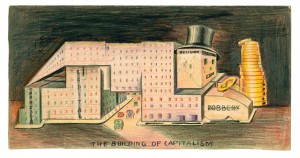Abraham Isaac Goldberg’s Artwork Recalls Pieces of the Past
Abraham Isaac Goldberg did not have the privilege of earning a living as an artist. Instead, he worked long hours in a factory to support his family, but during his lifetime, he created hundreds of sketches, drawings and paintings. His son, Haim, says that Goldberg’s artwork “brings back a certain time and place, a certain way of life that was difficult but enriching at the same time.” In 1929, Goldberg left the Lithuanian shtetl where he had grown up and immigrated to Montreal. Ten years later, when the German-Soviet Nonaggression Pact disintegrated, over 2,000 people from Goldberg’s shtetl—including his remaining family members—were massacred.
 Many of Goldberg’s sketches reflect his perspective on social and political events during the Great Depression and World War II. Haim Goldberg loves the drawings he describes as “the class-conscious, evil capitalist thugs with a big belly and a fistful of dollars.” One caricature of Stalin and Hitler depicts them as birds with human faces, kissing, each with a blade tucked under his wing while swastikas and hammer-and-sickles light up the sky behind them like fireworks. He also used his drawings to respond to personal crises. In 1950, Goldberg was hospitalized after a heart attack, and he filled a sketchbook with pictures both amusing and disturbing of the doctors and nurses who treated him.
Many of Goldberg’s sketches reflect his perspective on social and political events during the Great Depression and World War II. Haim Goldberg loves the drawings he describes as “the class-conscious, evil capitalist thugs with a big belly and a fistful of dollars.” One caricature of Stalin and Hitler depicts them as birds with human faces, kissing, each with a blade tucked under his wing while swastikas and hammer-and-sickles light up the sky behind them like fireworks. He also used his drawings to respond to personal crises. In 1950, Goldberg was hospitalized after a heart attack, and he filled a sketchbook with pictures both amusing and disturbing of the doctors and nurses who treated him.
Other works provide insight into the things and people that Goldberg loved. One self-portrait shows him at an easel with the pictures in his imagination surrounding him: a jury evaluating his artwork; the first prize he hoped to win; and his wife, for whom he so desperately wanted to succeed. According to Haim, Goldberg loved to paint landscapes. Haim remembers many trips to a remote cabin where his father would go off into the woods and paint. In contrast to the boldness of his political drawings, his portraits of relatives and strangers evoke tenderness with elegant lines and soft shadows. Goldberg passed away in 1970 at the age of 59, and for Haim, this exhibit is bittersweet. He wishes the artwork could have been displayed while his father was still alive to enjoy it, but, says Haim, “the overriding thing is to do it well now.”
“From My Father’s Hand: The Art of Abraham Isaac Goldberg, 1910-1970” is on display at the Chandler Gallery from August 15-September 12 with an opening reception on September 4 from 6-8 PM.



